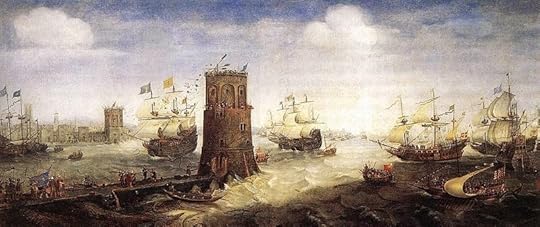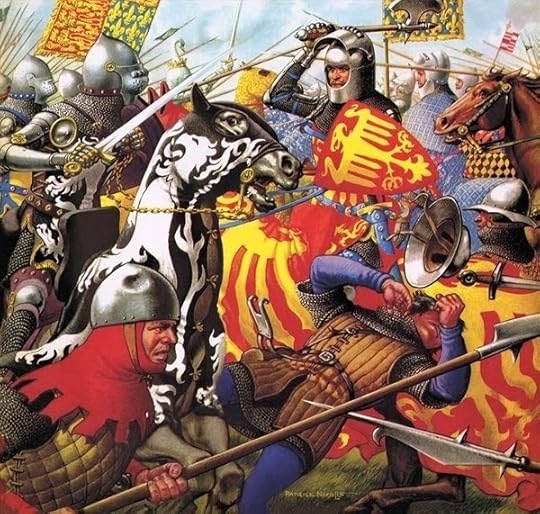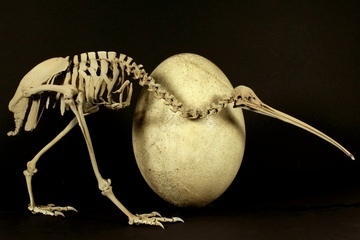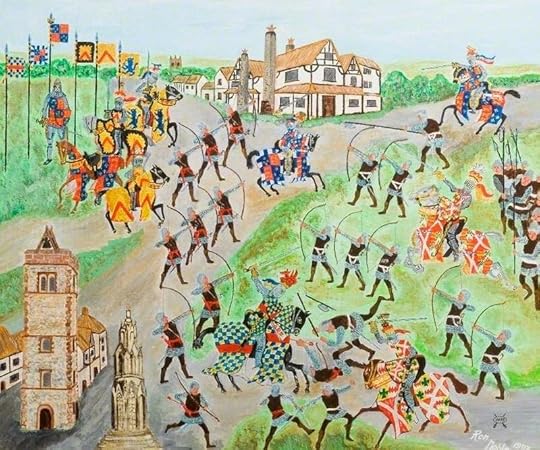MaryAnn Bernal's Blog, page 278
May 24, 2014
King Richard III Will Be Reburied in Leicester, High Court Rules
By Stephanie Pappas,

A judicial review concerning the final resting place of King Richard III has determined that the University of Leicester has the right to reinter the King's remains at Leicester Cathedral in England.
Richard III, who ruled England from 1483 to 1485, died at the Battle of Bosworth Field and was buried in a hasty grave in Leicester. The exact location was lost to history until 2012, when archaeologists on the hunt for the king's bones excavated a parking lot and found the skeleton, its spine bent with scoliosis and skull marred by battle wounds.
The decision, released today (May 23), is a response to a legal challenge by the Plantagenet Alliance, a group of indirect descendants and supporters who want a say in where King Richard III is reburied. The University of Leicester holds the excavation license for the King's grave, giving it the authority to reinter the bones under standard archaeological practice.
"I am absolutely delighted that the High Court has ruled that our exhumation license is valid," archaeologist Richard Buckley, who led the dig that made the discovery, said in a statement. "We may now make arrangements for the transfer of Richard III's remains from the University of Leicester to Leicester Cathedral where they may be reinterred with dignity and honor as befitting the last Plantagenet King of England."
The Ministry of Justice Secretary Chris Grayling echoed that delight in a statement today, though said he is "frustrated and angry that the Plantagenet Alliance — a group with tenuous claims to being relatives of Richard III — have taken up so much time and public money."
The Alliance, on their Facebook page today, responded to the decision: "We are naturally disappointed at the decision reached, but we are grateful to have had the opportunity to raise this nationally significant matter before the courts."
Rightful grave?
The University's plan has long been to rebury Richard's bones in the Leicester Cathedral, and has released plans showing a spare raise tomb surrounded by stained-glass windows.
 [image error]
[image error]

 An artist's conception of the tomb that will be built for King Richard III in Leicester Cathedral.
An artist's conception of the tomb that will be built for King Richard III in Leicester Cathedral.
Credit: Van Heyningen and HawardView full size imageBut the Plantagenet Alliance and others disapproved. Many said they would like to see the King reburied in York, a town where he spent much of his life.
"We believe that such an interment was the desire of King Richard in life," the Alliance wrote in a statement explaining their "King Richard III Campaign."
Richard III's posthumous fate raises passions, because the man himself has a bit of a cult following. Richard III enthusiasts, or Ricardians, are fascinated by the King and his reign and are often adamant about reclaiming him from the Shakespearian portrayal as a heartless, wicked villain.
"When you read about what Richard did with his parliament and how he behaved in military matters, you find quite an extraordinary character," Wendy Moorhen, the deputy chair of the Richard III Society, told Live Science last year.
Controversial king
Today's High Court decision comes after much debate.
Hearings regarding the University's reburial rights began in March. Advocates for not burying the King in Leicester requested a public consultation with views from the royal family, churches and those who claim to be the king's relatives. Richard III left no direct descendants, though DNA from his bones matched DNA from living descendants along his maternal line.
The King's genetic material is another source of controversy. The University of Leicester has announced plans to fully sequence Richard III's genome, which has some historians balking.
"Her Majesty the Queen would not allow exhumation of other royal remains, or the testing of them," John Ashdown-Hill, an independent historian involved with the search for the bones, told Live Science in February.
http://www.livescience.com/45847-richard-iii-will-be-reburied-in-leicester.html

A judicial review concerning the final resting place of King Richard III has determined that the University of Leicester has the right to reinter the King's remains at Leicester Cathedral in England.
Richard III, who ruled England from 1483 to 1485, died at the Battle of Bosworth Field and was buried in a hasty grave in Leicester. The exact location was lost to history until 2012, when archaeologists on the hunt for the king's bones excavated a parking lot and found the skeleton, its spine bent with scoliosis and skull marred by battle wounds.
The decision, released today (May 23), is a response to a legal challenge by the Plantagenet Alliance, a group of indirect descendants and supporters who want a say in where King Richard III is reburied. The University of Leicester holds the excavation license for the King's grave, giving it the authority to reinter the bones under standard archaeological practice.
"I am absolutely delighted that the High Court has ruled that our exhumation license is valid," archaeologist Richard Buckley, who led the dig that made the discovery, said in a statement. "We may now make arrangements for the transfer of Richard III's remains from the University of Leicester to Leicester Cathedral where they may be reinterred with dignity and honor as befitting the last Plantagenet King of England."
The Ministry of Justice Secretary Chris Grayling echoed that delight in a statement today, though said he is "frustrated and angry that the Plantagenet Alliance — a group with tenuous claims to being relatives of Richard III — have taken up so much time and public money."
The Alliance, on their Facebook page today, responded to the decision: "We are naturally disappointed at the decision reached, but we are grateful to have had the opportunity to raise this nationally significant matter before the courts."
Rightful grave?
The University's plan has long been to rebury Richard's bones in the Leicester Cathedral, and has released plans showing a spare raise tomb surrounded by stained-glass windows.
 [image error]
[image error]

 An artist's conception of the tomb that will be built for King Richard III in Leicester Cathedral.
An artist's conception of the tomb that will be built for King Richard III in Leicester Cathedral.Credit: Van Heyningen and HawardView full size imageBut the Plantagenet Alliance and others disapproved. Many said they would like to see the King reburied in York, a town where he spent much of his life.
"We believe that such an interment was the desire of King Richard in life," the Alliance wrote in a statement explaining their "King Richard III Campaign."
Richard III's posthumous fate raises passions, because the man himself has a bit of a cult following. Richard III enthusiasts, or Ricardians, are fascinated by the King and his reign and are often adamant about reclaiming him from the Shakespearian portrayal as a heartless, wicked villain.
"When you read about what Richard did with his parliament and how he behaved in military matters, you find quite an extraordinary character," Wendy Moorhen, the deputy chair of the Richard III Society, told Live Science last year.
Controversial king
Today's High Court decision comes after much debate.
Hearings regarding the University's reburial rights began in March. Advocates for not burying the King in Leicester requested a public consultation with views from the royal family, churches and those who claim to be the king's relatives. Richard III left no direct descendants, though DNA from his bones matched DNA from living descendants along his maternal line.
The King's genetic material is another source of controversy. The University of Leicester has announced plans to fully sequence Richard III's genome, which has some historians balking.
"Her Majesty the Queen would not allow exhumation of other royal remains, or the testing of them," John Ashdown-Hill, an independent historian involved with the search for the bones, told Live Science in February.
http://www.livescience.com/45847-richard-iii-will-be-reburied-in-leicester.html
Published on May 24, 2014 13:06
Ty The Bull: Rex's first interview with Donna Huber, Girl who r...
Ty The Bull: Rex's first interview with Donna Huber, Girl who r...: A Conversation with Brenda Perlin and Rex Baughman Two of the authors of Ty the Bull recently chatted about the book and the imp...
Rex's first interview with Donna Huber, Girl who reads!
A Conversation with Brenda Perlin and Rex Baughman
Two of the authors of Ty the Bull recently chatted about the book and the important message contained within its pages:
Everything seemed to fall apart for Ty when his parents got a divorce. At his wits end after being bullied endlessly, he started to ditch school. It wasn't until he met up with a skater named Peacock that things somehow turned around and he put the pieces of his life back together.
Brenda Perlin, author of the Brooklyn and Bo Chronicles, and Kim Mutch Emerson, publisher at Master Koda Select Publishing, teamed up with 11 year old Rex Baughman to tell an illustrated story based on the real life of an average 10 year old kid. Here is the transcript of a recent conversation Brenda and Rex had about bullying, writing a book and more.
Brenda: Why do you think kids bully other kids?
Rex: Because.they are mad at themselves and they are not feeling good and they want everybody else to feel the same way they do?Brenda That is such a really good answer! I wouldn’t have thought of all that. So you think they have low-self-esteem?
 Rex: Yeah
Rex: Yeah
Brenda: What are some of the things kids have bullied you about?
Rex: Like your fat and your stupid.
Brenda: But you are not fat you are not stupid.
Rex: I know. But I don’t know why.
Brenda: You have said people even pick on your name.
Rex: I know. It doesn’t make any sense.
Brenda: Why do you think a story about bullies is important?
Rex: To make others feel like that they shouldn’t care about what other people say or think. Just move on and don’t think about it. Just ignore it.
Brenda: What has helped you the most against bullies? I mean have you even been able to just ignore them?
Rex: Usually, just say like what’s you're problem and they usually get stuck and move.
Brenda: That is great.
Rex: Yes, I just try to ignore them.
Brenda: That’s even better.
Rex: Yeah, I think so.
Brenda: What is helping you the most dealing with your parents divorce?
Rex: Probably not think about it.
Brenda: It’s not getting easier for you?
Rex: Not that easy.
Brenda: You are not alone . It’s a hard topic.
Rex: I know.
Brenda: What makes you feel better about yourself?
Rex: Ummm… I really don’t know.
Brenda: Yes, you do! Rex!
Rex: Oh yeah, when I do good in school or when I do good art work or learn a new trick on the trampoline.
Brenda: That’s a good feeling.
Rex: Yeah.
Brenda: We used your artwork for the book. Do you think your work has recently improved? If so, why and how?
Rex: Oh yeah, for sure. I have. Probably because I have been putting more time into it and more thought. And putting more details.
Brenda: You have a natural talent but of course you have to nurture it.
Rex: Yes, I have to be careful how I put the marks on them. It’s better when I take my time.
Brenda: Let’s change the subject, what’s your favorite subject in school?
Rex: History. Actually.
Brenda: Really, how come?
Rex: Well, I have three. History, writing and math. History because it is a pretty easy subject for me. I have a good memory so I can remember all the things I have to study for.
Brenda: That is good. It’s not because it is interesting?
Rex: I like writing too because you get to make up stories and math because you get to solve equations. History is probably my favorite though.
Brenda: What do you want to do when you grow up?
Rex: I would have to say an owner of a company that I made and designed.
Brenda: That was fast! You are such an individual! I love that. I think you’re big on being your own person Rex!
Brenda: How does it feel to have your name on the cover of a published book?
Rex: I feel FAMOUS! I feel serious in the business word.
Brenda: That is wonderful. You are making something of yourself.
Rex: Yeah!
Thank you Donna for the beautiful page!
Rex's first interview with Donna Huber, Girl who reads!
A Conversation with Brenda Perlin and Rex Baughman

Two of the authors of Ty the Bull recently chatted about the book and the important message contained within its pages:
Everything seemed to fall apart for Ty when his parents got a divorce. At his wits end after being bullied endlessly, he started to ditch school. It wasn't until he met up with a skater named Peacock that things somehow turned around and he put the pieces of his life back together.
Brenda Perlin, author of the Brooklyn and Bo Chronicles, and Kim Mutch Emerson, publisher at Master Koda Select Publishing, teamed up with 11 year old Rex Baughman to tell an illustrated story based on the real life of an average 10 year old kid. Here is the transcript of a recent conversation Brenda and Rex had about bullying, writing a book and more.
Brenda: Why do you think kids bully other kids?
Rex: Because.they are mad at themselves and they are not feeling good and they want everybody else to feel the same way they do?Brenda That is such a really good answer! I wouldn’t have thought of all that. So you think they have low-self-esteem?
 Rex: Yeah
Rex: YeahBrenda: What are some of the things kids have bullied you about?
Rex: Like your fat and your stupid.
Brenda: But you are not fat you are not stupid.
Rex: I know. But I don’t know why.
Brenda: You have said people even pick on your name.
Rex: I know. It doesn’t make any sense.
Brenda: Why do you think a story about bullies is important?
Rex: To make others feel like that they shouldn’t care about what other people say or think. Just move on and don’t think about it. Just ignore it.
Brenda: What has helped you the most against bullies? I mean have you even been able to just ignore them?
Rex: Usually, just say like what’s you're problem and they usually get stuck and move.
Brenda: That is great.
Rex: Yes, I just try to ignore them.
Brenda: That’s even better.
Rex: Yeah, I think so.
Brenda: What is helping you the most dealing with your parents divorce?
Rex: Probably not think about it.
Brenda: It’s not getting easier for you?
Rex: Not that easy.
Brenda: You are not alone . It’s a hard topic.
Rex: I know.
Brenda: What makes you feel better about yourself?
Rex: Ummm… I really don’t know.
Brenda: Yes, you do! Rex!
Rex: Oh yeah, when I do good in school or when I do good art work or learn a new trick on the trampoline.
Brenda: That’s a good feeling.
Rex: Yeah.
Brenda: We used your artwork for the book. Do you think your work has recently improved? If so, why and how?
Rex: Oh yeah, for sure. I have. Probably because I have been putting more time into it and more thought. And putting more details.
Brenda: You have a natural talent but of course you have to nurture it.
Rex: Yes, I have to be careful how I put the marks on them. It’s better when I take my time.
Brenda: Let’s change the subject, what’s your favorite subject in school?
Rex: History. Actually.
Brenda: Really, how come?
Rex: Well, I have three. History, writing and math. History because it is a pretty easy subject for me. I have a good memory so I can remember all the things I have to study for.
Brenda: That is good. It’s not because it is interesting?
Rex: I like writing too because you get to make up stories and math because you get to solve equations. History is probably my favorite though.
Brenda: What do you want to do when you grow up?
Rex: I would have to say an owner of a company that I made and designed.
Brenda: That was fast! You are such an individual! I love that. I think you’re big on being your own person Rex!
Brenda: How does it feel to have your name on the cover of a published book?
Rex: I feel FAMOUS! I feel serious in the business word.
Brenda: That is wonderful. You are making something of yourself.
Rex: Yeah!
Thank you Donna for the beautiful page!

Published on May 24, 2014 04:46
History Trivia - Fifth Crusade leaves Acre for Egypt
May 24
 King David I of Scotland
King David I of Scotland
1153 David I, king of Scotland (1124-53), died, and Malcolm IV became king of Scotland.

1218 The Fifth Crusade left Acre for Egypt.

1337 The Hundred Years War between England and France began when France confiscated Gascony from Edward III.

1487 The ten-year-old Lambert Simnel was crowned in Christ Church Cathedral in Dublin, Ireland with the name of Edward VI in a bid to threaten King Henry VII's reign.

1543 Astronomer Nicolas Copernicus died
 King David I of Scotland
King David I of Scotland1153 David I, king of Scotland (1124-53), died, and Malcolm IV became king of Scotland.

1218 The Fifth Crusade left Acre for Egypt.

1337 The Hundred Years War between England and France began when France confiscated Gascony from Edward III.

1487 The ten-year-old Lambert Simnel was crowned in Christ Church Cathedral in Dublin, Ireland with the name of Edward VI in a bid to threaten King Henry VII's reign.

1543 Astronomer Nicolas Copernicus died

Published on May 24, 2014 04:44
May 23, 2014
Win £500 of LEGO Star Wars
Start your kids down the path to the light side with this amazing competition to win some great LEGO Star Wars sets
 For your chance to win £500 worth of LEGO Star Wars – including the amazing Death Star playset - just answer the question when you click on the link
For your chance to win £500 worth of LEGO Star Wars – including the amazing Death Star playset - just answer the question when you click on the link
This promotion runs from 12.01:00 am GMT on Start date (4th May 2014) until 11.59:59 p.m. GMT on End date (14th June 2014) (inclusive) (the “Promotion Period”).
http://lifestyle.uk.msn.com/advertorials/legostarwars/competition

 For your chance to win £500 worth of LEGO Star Wars – including the amazing Death Star playset - just answer the question when you click on the link
For your chance to win £500 worth of LEGO Star Wars – including the amazing Death Star playset - just answer the question when you click on the linkThis promotion runs from 12.01:00 am GMT on Start date (4th May 2014) until 11.59:59 p.m. GMT on End date (14th June 2014) (inclusive) (the “Promotion Period”).
http://lifestyle.uk.msn.com/advertorials/legostarwars/competition

Published on May 23, 2014 15:48
World War One battles: then & now
 Many locations of key battles in the first world war were so ravaged by conflict that the landscape still bears the scars 100 years on. By Ian Jones, MSN UK news editor. Image: Gerd Roth/DPA/AP 1 of 10 The Battle of Verdun ran for much of 1916 in the hills of north-east France. It was fought between German and French troops, and remains the longest battle in human history, with total casualties estimated to have numbered between 700,000 and one million.This composite picture shows (above) a battlefield near Verdun in 1917 and (below) the same area of countryside in 2014.
Many locations of key battles in the first world war were so ravaged by conflict that the landscape still bears the scars 100 years on. By Ian Jones, MSN UK news editor. Image: Gerd Roth/DPA/AP 1 of 10 The Battle of Verdun ran for much of 1916 in the hills of north-east France. It was fought between German and French troops, and remains the longest battle in human history, with total casualties estimated to have numbered between 700,000 and one million.This composite picture shows (above) a battlefield near Verdun in 1917 and (below) the same area of countryside in 2014.Click or swipe through for more images
http://news.uk.msn.com/in-pictures/world-war-one-battles-then-and-now/#image=1

Published on May 23, 2014 13:59
Closest Living Relative of Ancient Elephant Bird Is Tiny
By Charles Q. Choi, Live Science Contributor

An adult brown kiwi ( Apteryx australis ) beside the egg of a huge elephant bird ( Aepyornis maximus ). A new genetic study suggests these two bizarre and dramatically different birds are close cousins.
Credit: Kyle Davis and Paul Scofield, Canterbury Museum
Ostriches and their flightless relatives are found across the globe not because continental drift forced them apart, but rather because the ancestors of these birds spread across the world through flight, and only later became flightless, researchers say.
The largest species of flightless birds alive today are called the ratites, and include the ostrich, emu and rhea. These birds' ancestors were once even larger, such as the elephant bird, which stood 10 feet (3 meters) tall, and the moa, which could grow nearly as large. However, not all ratites are big; smaller ones include the chicken-sized kiwi.
Ratites live all over the planet: ostriches in Africa, emus in Australia, rheas in South America and kiwis in New Zealand. The now-extinct elephant birds once lived in Madagascar. Scientists had long thought different species of ratites evolved from equally flightless ancestors after the splitting of the supercontinent Gondwana separated different populations of the birds. The ancient Gondwana landmass included what is now Africa, South America, Australia, Antarctica, India, Arabia, New Zealand and Madagascar. [Image Gallery: 25 Amazing Ancient Beasts]
Beginning roughly 130 million years ago, Gondwana broke up into what are now the landmasses of the Southern Hemisphere. Africa and Madagascar also separated early on, about 100 million years ago. This suggests that the African ostrich and the Madagascan elephant birds are the oldest branches of the ratite family tree. Genetic analyses suggest the ostrich is indeed an old species, but whether this is also true of elephant birds had been uncertain, since the extinct status of these birds made it difficult to analyze their genetic information.
 [image error]
[image error]
 At 10 feet (3 meters) tall and weighing 550 pounds (250 kilograms), the elephant bird (Aepyornis maximus) wanders through the spiny forest of ancient Madagascar.
At 10 feet (3 meters) tall and weighing 550 pounds (250 kilograms), the elephant bird (Aepyornis maximus) wanders through the spiny forest of ancient Madagascar.
Credit: Brian ChooView full size imageAfter sequencing and analyzing genetic data from two species of elephant bird, scientists unexpectedly discovered the closest living relative of these birds is actually the small kiwi, and not the large ostrich, to which the elephant birds bear a closer physical resemblance.
"We found that elephant birds and kiwis arose from a common ancestor around 50 million years ago," said lead study author Kieren Mitchell, an evolutionary biologist at the University of Adelaide's North Terrace Campus in Australia. "This is after even New Zealand had become isolated."
In fact, elephant birds are only distantly related to ostriches, the researchers said.
"It was a real surprise that elephant birds are most closely related to kiwis — it's completely unprecedented," Mitchell told Live Science. "No one in over a century of study has proposed this relationship. This is because the two groups are just so different. Elephant birds are 3-meter [10 feet] tall, 275-kilogram [600 lbs.] giant herbivores from Madagascar, while kiwis are 5-kilogram [10 lbs.], secretive, shy, nocturnal omnivores from New Zealand."
The unexpected relationship between the elephant bird and the kiwi "highlights the power of evolution to produce radically different forms over a relatively short period of time," Mitchell said. The scientists detailed their findings in the May 23 issue of the journal Science.
The new study suggests that ratites did not evolve from populations of a common flightless ancestor that were separated by continental drift. Rather, it appears these flightless birds surprisingly evolved from ancestors that flew long distances to new corners of the world and then evolved independently to be flightless.
"We have to completely reconsider the origin of ratites as a whole," Mitchell said. "It totally changes our understanding of how these lineages moved around and arrived at their current homes. They can't have rafted on continental fragments — they must have flown."
The common flighted ancestor of modern ratites may have come from a now-extinct group of birds known as lithornithids. "They would have been quite small, unassuming birds, probably about the size of a chicken or quail, not dissimilar to tinamous from South America, a group of flighted birds closely related to ratites," Mitchell said. "Interestingly, lithornithid fossils are known from Europe and North America, places where we don't find ratites today, which is evidence that they were a widespread and highly mobile group."
The researchers estimate the ancestors of modern ratites dispersed around the world roughly 65 million years ago, around the time of the mass extinction that killed off the dinosaurs. "We think that this dispersal was probably in response to the opening of a huge range of ecological opportunities following the mass extinction. It would have been a free-for-all for those groups that survived," Mitchell said.
Fossils of large mammals do not start appearing until about 10 million years after that mass extinction. "After this point in history, competition with mammals seems to have prevented any new groups of large flightless birds from arising, except on islands where there are no mammals — for example, the dodo on Mauritius," Mitchell said. [Wipe Out: History's Most Mysterious Mass Extinctions]
It remains a mystery why these lineages of flying ratites all independently became flightless birds. "That's the million-dollar question," Mitchell said. "It's remarkable that elephant birds, rheas, moa, ostriches and emus all evolved their very similar body types and size independently from a small, flighted ancestor."
The answer could be linked to the end of the Age of Dinosaurs. After so many giant, flightless creatures went extinct with the dinosaurs' demise, these flying birds might have evolved to fill the empty roles in the ecosystems that followed, the researchers said.
"It may simply be that their ancestors were already predominantly ground-feeding birds, and so [they] naturally transitioned into the large, flightless niche when it became available. First come, first served," Mitchell said.
However, "right after the mass extinction that wiped out the dinosaurs around 65 million years ago, we see a number of other groups of giant, flightless birds turning up — phorusrhacids in South America, gastornithids in Eurasia and dromornithids in Australia — but each of these groups is now extinct," Mitchell said. "So it may not be that ratites are inherently predisposed to becoming giant and flightless, but that they have done it in a way that has allowed them to stand the test of time."
Although the puzzle about the evolution of these flightless birds is not yet solved, "we've added a crucial missing piece, and it's caused us to reevaluate how all the other pieces might really fit together," Mitchell said. "To learn more about the early history of ratites, we really need to find some new fossils, preferably from around 60 million years ago, to figure out where and when the ancestors of ratites were moving. Unfortunately such remains are extremely rare."
http://www.livescience.com/45824-evolution-of-flightless-birds.html

An adult brown kiwi ( Apteryx australis ) beside the egg of a huge elephant bird ( Aepyornis maximus ). A new genetic study suggests these two bizarre and dramatically different birds are close cousins.
Credit: Kyle Davis and Paul Scofield, Canterbury Museum
Ostriches and their flightless relatives are found across the globe not because continental drift forced them apart, but rather because the ancestors of these birds spread across the world through flight, and only later became flightless, researchers say.
The largest species of flightless birds alive today are called the ratites, and include the ostrich, emu and rhea. These birds' ancestors were once even larger, such as the elephant bird, which stood 10 feet (3 meters) tall, and the moa, which could grow nearly as large. However, not all ratites are big; smaller ones include the chicken-sized kiwi.
Ratites live all over the planet: ostriches in Africa, emus in Australia, rheas in South America and kiwis in New Zealand. The now-extinct elephant birds once lived in Madagascar. Scientists had long thought different species of ratites evolved from equally flightless ancestors after the splitting of the supercontinent Gondwana separated different populations of the birds. The ancient Gondwana landmass included what is now Africa, South America, Australia, Antarctica, India, Arabia, New Zealand and Madagascar. [Image Gallery: 25 Amazing Ancient Beasts]
Beginning roughly 130 million years ago, Gondwana broke up into what are now the landmasses of the Southern Hemisphere. Africa and Madagascar also separated early on, about 100 million years ago. This suggests that the African ostrich and the Madagascan elephant birds are the oldest branches of the ratite family tree. Genetic analyses suggest the ostrich is indeed an old species, but whether this is also true of elephant birds had been uncertain, since the extinct status of these birds made it difficult to analyze their genetic information.
 [image error]
[image error]
 At 10 feet (3 meters) tall and weighing 550 pounds (250 kilograms), the elephant bird (Aepyornis maximus) wanders through the spiny forest of ancient Madagascar.
At 10 feet (3 meters) tall and weighing 550 pounds (250 kilograms), the elephant bird (Aepyornis maximus) wanders through the spiny forest of ancient Madagascar.Credit: Brian ChooView full size imageAfter sequencing and analyzing genetic data from two species of elephant bird, scientists unexpectedly discovered the closest living relative of these birds is actually the small kiwi, and not the large ostrich, to which the elephant birds bear a closer physical resemblance.
"We found that elephant birds and kiwis arose from a common ancestor around 50 million years ago," said lead study author Kieren Mitchell, an evolutionary biologist at the University of Adelaide's North Terrace Campus in Australia. "This is after even New Zealand had become isolated."
In fact, elephant birds are only distantly related to ostriches, the researchers said.
"It was a real surprise that elephant birds are most closely related to kiwis — it's completely unprecedented," Mitchell told Live Science. "No one in over a century of study has proposed this relationship. This is because the two groups are just so different. Elephant birds are 3-meter [10 feet] tall, 275-kilogram [600 lbs.] giant herbivores from Madagascar, while kiwis are 5-kilogram [10 lbs.], secretive, shy, nocturnal omnivores from New Zealand."
The unexpected relationship between the elephant bird and the kiwi "highlights the power of evolution to produce radically different forms over a relatively short period of time," Mitchell said. The scientists detailed their findings in the May 23 issue of the journal Science.
The new study suggests that ratites did not evolve from populations of a common flightless ancestor that were separated by continental drift. Rather, it appears these flightless birds surprisingly evolved from ancestors that flew long distances to new corners of the world and then evolved independently to be flightless.
"We have to completely reconsider the origin of ratites as a whole," Mitchell said. "It totally changes our understanding of how these lineages moved around and arrived at their current homes. They can't have rafted on continental fragments — they must have flown."
The common flighted ancestor of modern ratites may have come from a now-extinct group of birds known as lithornithids. "They would have been quite small, unassuming birds, probably about the size of a chicken or quail, not dissimilar to tinamous from South America, a group of flighted birds closely related to ratites," Mitchell said. "Interestingly, lithornithid fossils are known from Europe and North America, places where we don't find ratites today, which is evidence that they were a widespread and highly mobile group."
The researchers estimate the ancestors of modern ratites dispersed around the world roughly 65 million years ago, around the time of the mass extinction that killed off the dinosaurs. "We think that this dispersal was probably in response to the opening of a huge range of ecological opportunities following the mass extinction. It would have been a free-for-all for those groups that survived," Mitchell said.
Fossils of large mammals do not start appearing until about 10 million years after that mass extinction. "After this point in history, competition with mammals seems to have prevented any new groups of large flightless birds from arising, except on islands where there are no mammals — for example, the dodo on Mauritius," Mitchell said. [Wipe Out: History's Most Mysterious Mass Extinctions]
It remains a mystery why these lineages of flying ratites all independently became flightless birds. "That's the million-dollar question," Mitchell said. "It's remarkable that elephant birds, rheas, moa, ostriches and emus all evolved their very similar body types and size independently from a small, flighted ancestor."
The answer could be linked to the end of the Age of Dinosaurs. After so many giant, flightless creatures went extinct with the dinosaurs' demise, these flying birds might have evolved to fill the empty roles in the ecosystems that followed, the researchers said.
"It may simply be that their ancestors were already predominantly ground-feeding birds, and so [they] naturally transitioned into the large, flightless niche when it became available. First come, first served," Mitchell said.
However, "right after the mass extinction that wiped out the dinosaurs around 65 million years ago, we see a number of other groups of giant, flightless birds turning up — phorusrhacids in South America, gastornithids in Eurasia and dromornithids in Australia — but each of these groups is now extinct," Mitchell said. "So it may not be that ratites are inherently predisposed to becoming giant and flightless, but that they have done it in a way that has allowed them to stand the test of time."
Although the puzzle about the evolution of these flightless birds is not yet solved, "we've added a crucial missing piece, and it's caused us to reevaluate how all the other pieces might really fit together," Mitchell said. "To learn more about the early history of ratites, we really need to find some new fossils, preferably from around 60 million years ago, to figure out where and when the ancestors of ratites were moving. Unfortunately such remains are extremely rare."
http://www.livescience.com/45824-evolution-of-flightless-birds.html

Published on May 23, 2014 13:53
Biggest shipwreck finds in history
 By Talal Al-Khatib
By Talal Al-KhatibThe recent identification of Columbus' lost ship is among the most significant finds in marine archaeology. Beneath the ocean waves lurks many other vessels of historical significance that have disappeared from history, only to resurface from the depths centuries later.
1. The RMS TitanicUndoubtedly the most famous shipwrecks in history, thanks in part to a hugely successful film in the 1990s based on the sinking, the RMS Titanic was for a time the largest ship in history, and as a consequence the largest shipwreck. Despite its size, however, the whereabouts of the lost ocean liner were unknown for decades following its disappearance in 1912.
That changed in 1985, when the Titanic was found at a depth of 12,500 feet off the coast of Newfoundland. The shipwreck is composed to two large sections that drifted and settled about a third of a mile apart.
Because of its size and the state of deterioration of the vessel, raising it from the ocean's depths is prohibitively difficult. The Titanic also is now home to practically an entire underwater ecosystem, with a community of crabs, fish and bacteria now inhabiting its decks.
Titanic Being Eaten by Destructive Bacteria2. The Queen Anne's RevengeThe flagship of one of the most notorious pirates in history, the Queen Anne's Revenge was missing for centuries after it ran aground in 1718, the same year that Edward Teach, better known as Blackbeard, would meet his end.
In 1995, a shipwreck was discovered off the coast of North Carolina that was thought to be the legendary pirate frigate. It took another 15 years of piecing together the evidence before researchers would claim with certainty that the wreck was in fact the Queen Anne's Revenge.
Items recovered from the wreck include a bell inscribed with the date 1705, apothecary weights, some gold and of course a cache of many weapons, including the cannon seen in this photo.
Arsenal of the Dread Pirate Blackbeard3. The Whydah GallyUnlike the Queen Anne's Revenge, there was no mistaking the Whydah Gally for any other vessel soon after the pirate ship was discovered in 1984.
The flagship of Captain "Black Sam" Bellamy, the ship ran aground and sank off the coast of Cape Cod following an intense storm in 1717. Relying on a map assembled by a salvager who was a contemporary of Bellamy, modern-day marine explorers were able to ascertain the location of the shipwreck.
Among the more than 200,000 artifacts discovered abroad, which included cannons, coins and more, was the ship's bell, bearing the simple inscription "The Whydah Gally 1716." It was the first ever discovery and authentication of a pirate ship.
Pirates: A Long, Scurvy History4. The Black SwanIf you found a half billion dollars worth of sunken treasure, would you be able to keep it a secret?
In 2007, the underwater salvage company Odyssey Marine Expeditions discovered a Colonial-era shipwreck in the Atlantic Ocean that yielded more than half a million silver coins, hundreds of gold coins and more. Codenamed "The Black Swan," the haul was thought to belong to the Spanish navy frigate, Nuestra Señora de las Mercedes, which sank in the early 19th century.
The discovery led to a series of court battles between the Spanish government and Odyssey, with the company being forced to relinquish the entire load to Spain. The Peruvian government had also sought to lay claim to the treasure, insisting that the coins were mined and minted within its borders.
Black Swan Shipwreck Ordeal Comes to End5. Nuestra Señora de AtochaThe 1622 wreck of the Nuestra Señora de Atocha is among the most valuable in history. The Spanish treasure ship had been hauling the wealth of the New World in its cargo hold, laden with jewels and precious metals.
Some 460 years later, the shipwreck would be found by Mel Fisher, an Indiana chicken farmer turned treasure hunter. The immense fortune Fisher uncovered came at a hefty price, however. On a previous expedition to find the sunken vessel, Fisher's wife and son died after their boat capsized while looking for the treasure.
Since it's discovery, the Nuestra Señora de Atocha is estimated to hold around $450 million to half a billion dollars worth of treasure, and excavation work to find what remains of the ship's haul continues to this day.
Family Finds $300,000 in Gold Off Florida Coast6. The VasaThe Vasa is a 17th-century Swedish warship that's famous not so much for its (dismal) sailing career as it is its afterlife after being salvaged.
An expensive and ornate vessel built for king Gustavus Adolphus, the Vasa embarked on its maiden voyage in 1628, sailed about half a mile from the shore, and promptly sank. The bronze cannons abroad the wreck were salvaged, but the ship itself was left forgotten.
In the 1950s, the Swedish government devised a rescue operation for the forgotten vessel, finally bringing it back above water in 1961. Despite spending three and a half centuries underwater, the Vasa was remarkably well preserved and as a result later restored and put on display, becoming a popular tourist attraction in Sweden.
11,000-Year-Old Settlement Found Under Baltic Sea7. The Silver StandardThe British treasure ship S.S. Gairsoppa may not be a household name, but the discovery of this wreck in 2011 may be the deepest and largest precious metal recovery in history, as reported that year by Discovery News.
The 412-foot ship in 1941 had more than 1,200 bars of silver, totaling 1.4 million ounces, aboard when it sank after being torpedoed by a German U-boat. Discovered by Odyssey, the ship was found three miles below the waters of the North Atlantic.
$36 Million in Silver Hauled From WWII Shipwreck8. The 'Ship of Gold'The S.S. Central America isn't the most famous or even the most valuable shipwreck in history. But with "The Ship of Gold" as a nickname, it arguably has the best branding.
In 1857, the steamer sailed from San Francisco on its way to New York, a journey at the time that required it to carry its 10 tons worth of gold mined during the California gold rush around two continents. After a hurricane hit off the coast of South Carolina, the ship was lost, an event so significant that it actually contributed to the panic of 1857.
The shipwreck was discovered in 1988, bearing an estimated $100 million-$150 million worth of gold, including one ingot weighing 80 pounds that later sold for $8 million all by itself.
Gold Rush's Poisonous Legacy: Mercury9. The Diamond ShipwreckIt's hard not to feel sorry for the sailors aboard the Bom Jesus, a 16th century Portuguese trading vessel.
Sailing in a ship laden with gold and ivory, the ship was caught in a storm while rounding the southern tip of Africa. After days of battling the elements at sea, the ship and its crew were tossed onto a coast that holds more than a hundred million carats of diamonds. Although the men aboard the Bom Jesus were surrounded by almost incomprehensible wealth, none of the men aboard what has become known as the Diamond Shipwreck survived.
The wreck was finally uncovered in 2009 by a geologist working for De Beers. An archaeological investigation into the site yielded more than 2,000 gold coins, 11 tons of copper ingots, cannons, swords, ivory and more, according to Nhttp://www.foxnews.com/science/2014/05/22/the-biggest-shipwreck-finds-in-history/ational Geographic.

Published on May 23, 2014 13:46
Diane Turner - London Rocks - 23.05.2014
Published on May 23, 2014 13:35
History Trivia - Joan of Arc captured at Compiegne
May 23

1275 King Edward I of England ordered the cessation of persecution of French Jews.

1430 Joan of Arc was captured at Compiegne and sold to the British.

1498 Girolamo Savonarola was burned at the stake in Florence, Italy, on the orders of Pope Alexander VI (Rodrigo Borgia).

1533 The marriage of King Henry VIII to Catherine of Aragon was declared null and void.


1275 King Edward I of England ordered the cessation of persecution of French Jews.

1430 Joan of Arc was captured at Compiegne and sold to the British.

1498 Girolamo Savonarola was burned at the stake in Florence, Italy, on the orders of Pope Alexander VI (Rodrigo Borgia).

1533 The marriage of King Henry VIII to Catherine of Aragon was declared null and void.

Published on May 23, 2014 05:16
May 22, 2014
History Trivia - The Macedonian army of Alexander the Great defeats Darius III of Persia
May 22

334 BC – The Macedonian army of Alexander the Great defeated Darius III of Persia in the Battle of the Granicus. 3

37 Constantine the Great, the first Roman Emperor to convert to Christianity died.

1377 Pope Gregory XI issued five papal bulls to denounce the doctrines of English theologian John Wycliffe.

1455 Wars of the Roses: at the First Battle of St Albans, Richard, Duke of York, defeated and captured King Henry VI of England.


334 BC – The Macedonian army of Alexander the Great defeated Darius III of Persia in the Battle of the Granicus. 3

37 Constantine the Great, the first Roman Emperor to convert to Christianity died.

1377 Pope Gregory XI issued five papal bulls to denounce the doctrines of English theologian John Wycliffe.

1455 Wars of the Roses: at the First Battle of St Albans, Richard, Duke of York, defeated and captured King Henry VI of England.

Published on May 22, 2014 07:01




